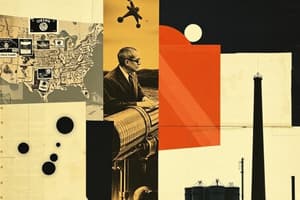Podcast
Questions and Answers
What is another name for PETROLEUM?
What is another name for PETROLEUM?
Crude oil
What are hydrocarbons composed of?
What are hydrocarbons composed of?
Hydrogen and carbon
When did Edwin Drake drill the first oil for petroleum extraction?
When did Edwin Drake drill the first oil for petroleum extraction?
- 1859 (correct)
- 1895
- 1860s
- 1846
In which year did Standard Oil break up into 34 companies?
In which year did Standard Oil break up into 34 companies?
Exxon, Mobil, Chevron, Texaco, Gulf, BP, and Shell formed an organization called Seven Sisters.
Exxon, Mobil, Chevron, Texaco, Gulf, BP, and Shell formed an organization called Seven Sisters.
During refining of crude oil, many ________ are produced.
During refining of crude oil, many ________ are produced.
Match the following transport methods with their capacities:
Match the following transport methods with their capacities:
Flashcards are hidden until you start studying
Study Notes
Introduction to Petroleum Refining
- Petroleum is a complex mixture of hydrocarbons and natural gas (NG)
- Also known as crude oil, it is made up of hydrocarbons containing hydrogen and carbon, and natural gas containing oxygen, nitrogen, and sulfur
History of Petroleum
- 1846: Canadian archeologist Abraham Gesner developed a petroleum distillation process, with kerosine as the main product
- 1850s: Distillation process started to be used widely in the USA, with 8 million barrels of kerosene produced per year
- 1859: Edwin Drake drilled the first oil well for petroleum extraction, marking the beginning of mechanical drilling
- 1860s: Rapid growth of petroleum companies in North America
- 1895: Standard Oil tried to share the petroleum market with the Russian government but was rejected
- 1911: Standard Oil broke up into 34 companies
- 1928: Exxon, Mobil, Chevron, Texaco, Gulf, British Petroleum (BP), and Shell formed an international organization called Seven Sisters
Drilling and Refining
- Onshore drilling involves positioning the hoisting equipment and lowering the bit and drill collar into the well hole
- Offshore drilling allows for exploration of underwater oil reserves
- The petroleum product life cycle involves upstream (exploration and production), midstream (transportation and processing), and downstream (marketing and sales) aspects
Midstream and Downstream
- Midstream business consists of transportation and processing through pipelines and other transport systems
- Downstream business deals with marketing and sales, which reaches consumers through gasoline stations, and involves processing and purifying of raw NG
Characteristics of Crude Oil
- Quality of crude oil is described based on density/specific gravity and sulfur content
- Lighter colors indicate higher quality
- Classification of oil is based on maturation, with higher quality oils having a lighter color
Refining Process
- Distillation is a refining process that separates crude oil into various products
- The transformation of crude oil into various products involves a refining process
Oil Fields and Production
- Malaysia's oil and gas fields are mainly found offshore of Peninsula Malaysia and east coast
- Most of the country's oil fields contain low-sulfur, high-quality crude
- 37 oil fields and 11 gas fields are under development
- The Tapis field is the largest oil producer, producing very light and sweet crude with API gravity of 44° and sulfur content of 0.08% by weight
Refineries in Malaysia
- Malaysia has 6 refineries, with a total processing capacity of 544,832 bbl/d
- The 3 largest refineries are Shell Port Dickson refinery, Petronas Melaka-I, and Melaka-II refineries
Studying That Suits You
Use AI to generate personalized quizzes and flashcards to suit your learning preferences.




